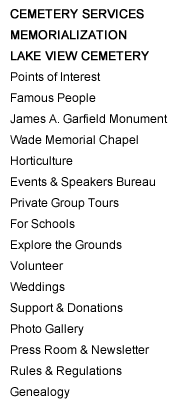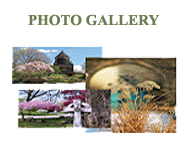Horticulture at Lake View Cemetery
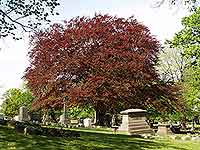 In 1869, Lake View’s founders used horticulture as an integral part of their cemetery planning process. In doing so, they created a showcase of trees and shrubbery, cultivated for scientific, ornamental and educational purposes – an arboretum in every aspect of the word.
In 1869, Lake View’s founders used horticulture as an integral part of their cemetery planning process. In doing so, they created a showcase of trees and shrubbery, cultivated for scientific, ornamental and educational purposes – an arboretum in every aspect of the word.
In scientific terms, Lake View straddles Lake Erie’s plain and its ridge at a distance of five-miles from its southern shore. According to records, the Cemetery’s founders 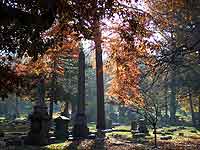 were inspired by the lake view seen from a variety of elevations when choosing a name. Our location benefits from numerous horticultural advantages that enhance growing conditions. In addition, the west branch of Dugway Brook flows north through the western portion of the Cemetery where it cut a steep riparian valley. An abundance of stately upland oaks, stretching across the majority of Lake View’s plateau attests to our well-drained soils. The same oaks and other mature trees also provide shelter for more tender plants, thereby increasing our plant catalog. Some of the oldest cultivated trees in the Greater Cleveland area can be seen on the grounds.
were inspired by the lake view seen from a variety of elevations when choosing a name. Our location benefits from numerous horticultural advantages that enhance growing conditions. In addition, the west branch of Dugway Brook flows north through the western portion of the Cemetery where it cut a steep riparian valley. An abundance of stately upland oaks, stretching across the majority of Lake View’s plateau attests to our well-drained soils. The same oaks and other mature trees also provide shelter for more tender plants, thereby increasing our plant catalog. Some of the oldest cultivated trees in the Greater Cleveland area can be seen on the grounds.
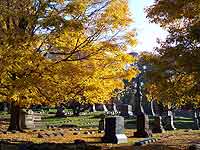 In 1869, Lake View’s grounds were thoughtfully planned to create the decorative urban oasis it is today. Ornamentally speaking, the combination of two 19th century developments gave birth to an innovative style called the “garden cemetery.” Cemeteries dating from colonial times were considered unhealthy and unattractive due to their eventual decline in maintenance and lack of ornamentation. Add to that a movement called “Romanticism,” which promoted lying loved ones to rest in a peaceful, natural setting in order to alleviate the ever-present pain of death. Landscape design principles focused on winding roadways and rolling hills integrated with water elements to create inspiration and awe while soothing the soul for the viewer. Most importantly, specimen plantings were carefully placed to unify and balance each of these elements and accentuate a park-like setting.
In 1869, Lake View’s grounds were thoughtfully planned to create the decorative urban oasis it is today. Ornamentally speaking, the combination of two 19th century developments gave birth to an innovative style called the “garden cemetery.” Cemeteries dating from colonial times were considered unhealthy and unattractive due to their eventual decline in maintenance and lack of ornamentation. Add to that a movement called “Romanticism,” which promoted lying loved ones to rest in a peaceful, natural setting in order to alleviate the ever-present pain of death. Landscape design principles focused on winding roadways and rolling hills integrated with water elements to create inspiration and awe while soothing the soul for the viewer. Most importantly, specimen plantings were carefully placed to unify and balance each of these elements and accentuate a park-like setting.
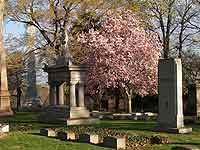 Last but not least, Lake View’s grounds provide endless opportunities for horticultural discovery and education. Examples include: our Moses Cleaveland Trees, designated during the botanical survey undertaken to commemorate the bicentennial of Cleveland’s founding; the Lakeview’ Ginkgo, an upright narrow form first found here on our grounds; our Ohio State
Last but not least, Lake View’s grounds provide endless opportunities for horticultural discovery and education. Examples include: our Moses Cleaveland Trees, designated during the botanical survey undertaken to commemorate the bicentennial of Cleveland’s founding; the Lakeview’ Ginkgo, an upright narrow form first found here on our grounds; our Ohio State 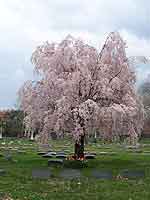 Champion Trees; the annual blossoming of Daffodil Hill – a planting of thousands of bulbs. To enhance Lake View’s use as an arboretum, a horticultural identification program was established to label native and unusual specimens with signs that provide their botanical and common names. New plantings are also mapped and recorded with an accession number. It is the goal of our Horticulture Program to update and maintain approximately 1,000 recorded plantings throughout Lake View.
Champion Trees; the annual blossoming of Daffodil Hill – a planting of thousands of bulbs. To enhance Lake View’s use as an arboretum, a horticultural identification program was established to label native and unusual specimens with signs that provide their botanical and common names. New plantings are also mapped and recorded with an accession number. It is the goal of our Horticulture Program to update and maintain approximately 1,000 recorded plantings throughout Lake View.
With a legacy of renewal and reflection for the living under the canopy of an arboretum, Lake View Cemetery displays Cleveland’s history for all to see; a treasure we strive to enhance and preserve.
| For additional information on Horticulture click on the following links: | |
|---|---|
Soil Composition and Geology
The mounded topography of Section 1, travels south from the Euclid Avenue entry concealing an ancient sand dune that represents the sandier and loamier soils permeating our lake plain area. The predominant soil classified on Lake View’s lake plain is Loudonville-Urban land complex, rolling (LuC). Characterized by layers of friable silt loam, the lower area of Lake View is needless to say: well drained.
Lake View’s plateau is dominated by Mitiwanga-Urban land complex, undulating (MxB), characterized by a friable 10-inch thick layer of yellowish brown silty clay loam that is well known to many gardeners. The ‘C horizon’ or substratum is a yellowish, brown, mottled, friable, fraggy loam underlain with Berea Sandstone bedrock that was quarried and set as building material around the cemetery.
Berea sandstone is porous sandstone that absorbs ozone and other atmospheric pollutants. The resulting blackened patina seen on older structures acts as a protective coating on the stone. Berea Sandstone was easily quarried from an exposed escarpment in the Dugway Brook corridor near Mayfield Road. The Physiographical placement of Lake View Cemetery is on the Berea Escarpment in the Galion Glaciated Low Plateau which can be seen on the Physiographic map of Ohio at http://www.dnr.state.oh.us/portals/10/pdf/physio.pdf.
More information on these soil types can be found in the Soil Survey of Cuyahoga County, Ohio.
USDA Plant Hardiness Zone Map
Lake View Cemetery is sited within the buffering reach of Lake Erie, which typically delays our first fall frost by four to six weeks after surrounding areas of Greater Cleveland receive theirs. Many bedding plants, such as geraniums, planted throughout the Cemetery hold their blooms until the hard freezes of December arrive. Our USDA Plant Zone 6A designation places us on par with the length of the growing season in southern Ohio. Thriving trees and shrubs that are tender to other parts of the Cleveland area confirm the enhanced protection of our growing conditions.
Native Plant Communities
Original vegetation in the Dugway Brook Riparian Corridor, which traverses through Lake View Cemetery, would have mimicked the flora in Euclid Creek and Doan Brook. Silver maple, bitternut hickory, basswood, red ash and black walnut were probably frequent on the low terraces where flooding occurred. White oak, tulip poplar, black oak, sassafras, black cherry and chestnut oak, were and are common on steep upper slopes and ridges of the valley. American chestnut also would have likely been present.
Owing that neither original landscape plans nor early, detailed climax woodland surveys exist for Lake View’s plateau and lake plain area of Lake View Cemetery, Gordon’s 1966 publication, Natural Vegetation Map of Ohio at the Time of the Earliest Land Survey serves as a benchmark describing the lake plain forest as a Beech Forest. Extrapolation of Gordon’s map to our geography shows a Mixed-oak Forest situated on our lake ridge. This forest type is further described in Plant Communities of the Midwest-2001 Appendix: Association Descriptions as an ‘American Beech-Sugar Maple Glaciated Midwest Forest’.
Anderson’s 1982 Plant Communities of Ohio: A Preliminary Classification and Description subdivides Gordon’s categories into more articulately defined forest types. For example, the Mixed-oak Forest designation for the lake ridge area of Lake View may occur as an Appalachian Oak Forest or an Oak-Hickory Forest. Comparing Lake View’s forest to each forest type leaves discrepancies in both categories.
Plant Communities of the Midwest-2001 Appendix: Association Descriptions describes the plateau of Lake View with a Midwestern White Oak - Red Oak Forest with a pocket of White Oak - Chestnut Oak - Maple Acid Forest on the west ridge of Dugway Brook. More information on Ohio’s forest types can be found at http://www.natureserve.org/library/ohiosubset.pdf.
Horticultural History
Several developments in the 19th century gave birth to a new style of burial ground called the “garden cemetery,” of which Lake View is one of the most outstanding examples. Intown cemeteries dating from colonial times had become barren through the initial lack of ornamentation and subsequent decline in maintenance. Additionally, North American cities were not designed with green space for their citizens’ wellbeing. European poets and philosophers also instilled a new vision that permeated Western culture during a period called Romanticism; the art of infusing nature into Western life. The pain of death could be alleviated through the Romantic notion of loved ones laid to rest in a peaceful, natural setting. Leading citizens of Boston established a rural garden cemetery outside Cambridge giving it the bucolic name, Mount Auburn in 1831. This garden cemetery, the first of its kind in the United States, became the prototype for Lake View. Landscape principles were borrowed from 18th century English estates by incorporating winding paths over rolling hills, creating new scenes with every curve. Water and sweeping vistas were intrinsic design elements. Most importantly, specimen plantings were set in a planned design to fully accentuate each turn of the path in unity and balance.
Adolph Strauch was a renowned landscape architect, born in the province of Silesia, Prussia in 1822. Strauch began learning the art of landscaping around 1838, at age sixteen, when he studied in Vienna, Austria under gardeners at Schönbrunn Palace and Schloss Laxenburg. It was at Schönbrunn Palace that Strauch was recognized by Hermann von Pückler-Muskau, a celebrated teacher of landscape design and horticulture. By 1845, Strauch had left Vienna obtain a more thorough idea of the gardening techniques used in places like Belgium, Germany and France.
On a trip to the United States, Strauch mistakenly landed in Cincinnati, Ohio, where he earned commissions to landscape several adjoining estates into a grandiose park. His work was noticed at the nearby Spring Grove Cemetery, where he was hired in 1855, incorporating his principles of park design at the Cemetery. Strauch was promoted to Superintendent in 1859, where he stayed for the remainder of his working life. He became known particularly for his layout designs of cemeteries, like Graceland in Chicago, Illinois. Strauch also laid out many parks in Cincinnati, Ohio, including Eden Park, Burnet Woods and Lincoln Park. Although Strauch never gained much fame outside the Midwest, Frederick Law Olmsted, Sr. acknowledged the influence of Strauch on his own work.
In 1869, the trustees of Lake View Cemetery asked Spring Grove to grant Adolph Strauch a leave of absence so that he could be employed to layout the grounds. Strauch’s vision for Lake View was to create a garden cemetery and include in its use a “museum, arboretum, bird sanctuary, park, historical archive and landmark.” Strauch instilled Lake View’s trustees with the concept that garden cemeteries should be regulated by uniformity of lot size and monument specifications to preserve the unity and integrity of the landscape design; a concept that became known as the “lawn plan.” (1890 diagram of Lake View)
Lake View’s board of trustees began their fulfillment of Strauch’s plan in 1871 when a “planter & Gen’l manager of trees” was engaged for the annual salary of $800.00. The London Illustrated News published an engraving of Lake View on the occasion of President Garfield’s interment in 1881, acknowledging the guidance of Adolph Strauch and the skillful people who executed his design by stating, “The cemetery has been laid out and planted with great taste and magnificent effect.”
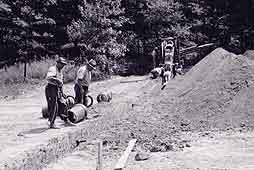 Lake View Cemetery expanded rapidly between 1890 to the onset of the Depression. The foresight of its Board methodically approved the building of infrastructure to transform rolling forested terrain into a shaded Victorian garden. Demanding tasks, such as grading, installing drainage and water lines, constructing roads and curbing, were accomplished by a crew of newly arrived Italian gardeners and stone cutters, many of whom settled in the adjacent community known as Little Italy. A landscape gardening firm from Boston, E. E. Bowditch, planned and supervised the improvements.
Lake View Cemetery expanded rapidly between 1890 to the onset of the Depression. The foresight of its Board methodically approved the building of infrastructure to transform rolling forested terrain into a shaded Victorian garden. Demanding tasks, such as grading, installing drainage and water lines, constructing roads and curbing, were accomplished by a crew of newly arrived Italian gardeners and stone cutters, many of whom settled in the adjacent community known as Little Italy. A landscape gardening firm from Boston, E. E. Bowditch, planned and supervised the improvements.
In 1903, responsibility for the cemetery’s planting program was placed in the capable hands of a German nurseryman named Ernst Muny. For the next 55-years, Muny devoted himself to the challenge of turning Lake View into a showcase. In 1910 alone, 6,000 trees, shrubs and bedding plants were installed and maintained. Muny kept a 7.5 acre nursery to raise stock and trade plants with other nurserymen. Son Walter started as a member of the tree service crew and worked his way up to foreman. “My grandfather and father were responsible for developing Lake View into an arboretum,” said Richard Muny. “They both saw it as a mission.”
The trustees shared Muny’s vision and considered turning 50 acres over to the Albert F. Holden estate in the mid-1910’s to establish a formal arboretum, in honor of his posthumous wish for a scientific garden in memory of his daughter who died in her youth. Olmsted Brothers, the firm that succeeded their noted father after his retirement, was commissioned to create a landscape plan for the proposed arboretum. The design was scrapped as unsuitable for the site after a decade of deliberation. Coincidentally, Frederick Law Olmsted, Sr. declined to accept a commission to expand the cemetery in 1894.
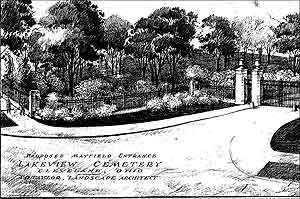 At the close of the 1920’s, noted Cleveland-based landscape architect A.D. Taylor was retained to prepare a master plan, using before-and-after pictures to show how the extensive rearrangement and reinforcement of existing plantings would provide better framing of memorials; help screen views; add seasonal interest; and create more pleasing vistas. The most imaginative recommendation called for a reflecting pond in an area north of the Cemetery’s Jeptha H. Wade Chapel.
At the close of the 1920’s, noted Cleveland-based landscape architect A.D. Taylor was retained to prepare a master plan, using before-and-after pictures to show how the extensive rearrangement and reinforcement of existing plantings would provide better framing of memorials; help screen views; add seasonal interest; and create more pleasing vistas. The most imaginative recommendation called for a reflecting pond in an area north of the Cemetery’s Jeptha H. Wade Chapel.
Delayed by the Depression, A.D. Taylor’s plan was left for a successor chief executive, Charles B. Gleason, to implement. His advice from Taylor’s landscape designer Charles S. (Pete) Knight was, “Plant, plant, plant,” when Gleason asked how to make Lake View a “happy place.” Gleason was the first male president of the former Garden Center of Greater Cleveland (now 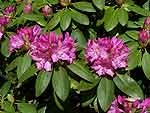 the Cleveland Botanic Garden). Together, Gleason and Knight executed an ambitious program that introduced thousands of flowering trees and shrubs into a largely monochromatic landscape. Their vision was maintained and enhanced by successive administrations, starting with another Garden Center alumnus, Arnold B. Davis whose handiwork lives on today in Lake View’s gorgeous spring colors.
the Cleveland Botanic Garden). Together, Gleason and Knight executed an ambitious program that introduced thousands of flowering trees and shrubs into a largely monochromatic landscape. Their vision was maintained and enhanced by successive administrations, starting with another Garden Center alumnus, Arnold B. Davis whose handiwork lives on today in Lake View’s gorgeous spring colors.
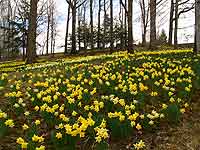 The annual blossoming of Daffodil Hill is a collection of 100,000 bulbs that were first planted in the 1940’s, and has remained one of Lake View’s most popular attractions. An initial donation of tens-of-thousands of bulbs, representing more than 50 cultivars, came from local daffodil fancier, William H. Weir, M.D.
The annual blossoming of Daffodil Hill is a collection of 100,000 bulbs that were first planted in the 1940’s, and has remained one of Lake View’s most popular attractions. An initial donation of tens-of-thousands of bulbs, representing more than 50 cultivars, came from local daffodil fancier, William H. Weir, M.D.
Moses Cleaveland Trees
Commemoration of the Bicentennial of Cleveland’s founding included a botanical survey to designate any tree calculated to have been present when Moses Cleaveland landed on the shore of the Cuyahoga River. Four specimens are located on the grounds of Lake View and can 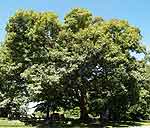 be readily seen. The white oak (Quercus alba) is distinguished by its long out stretched branches near the southeast bend of Section 8. The grand Tuliptree (Liriodendron tulipifera), in Section 6, is easy to spot with its enormous root flare and distinctively tall height. This specimen is best appreciated when one stands at
be readily seen. The white oak (Quercus alba) is distinguished by its long out stretched branches near the southeast bend of Section 8. The grand Tuliptree (Liriodendron tulipifera), in Section 6, is easy to spot with its enormous root flare and distinctively tall height. This specimen is best appreciated when one stands at 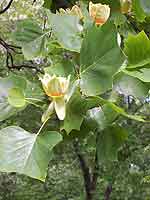 the base of the tree and gazes straight upward. Section 6 is located between Wade Chapel and the Rockefeller monument. The last two specimens are located near each other on the shaded northeast side of Section 1. An American beech (Fagus grandiflora) and second Tuliptree stand side by side with an extended height and slenderness unbecoming of 200-year old plus trees. The beech appears healthy and free of beech bark disease and structurally sound with no evident cavities which can be rare for an American beech. The tuliptree stands equally as tall and healthy as the beech.
the base of the tree and gazes straight upward. Section 6 is located between Wade Chapel and the Rockefeller monument. The last two specimens are located near each other on the shaded northeast side of Section 1. An American beech (Fagus grandiflora) and second Tuliptree stand side by side with an extended height and slenderness unbecoming of 200-year old plus trees. The beech appears healthy and free of beech bark disease and structurally sound with no evident cavities which can be rare for an American beech. The tuliptree stands equally as tall and healthy as the beech.
Ginkgo biloba ‘Lake View’
When looking at the distinctive pronounced buds on the many Gingko trees planted in Lake View during the dormant season or the telltale bisected leaves during the growing season, take note of the column like form of some of the trees. Certain Ginkgo specimens hold a tight, apical dominance to create this column-shaped growth. True to a cultivated variety, tip cuttings will grow in the columnar form when they are rooted or grafted to generate a new tree.
State Champion Trees
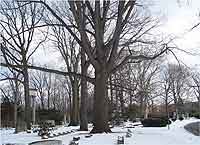 Quercus prinus-Chestnut Oak. Specimens of this oak can be seen abundantly around Lake View so it stands to good reason that a state champion specimen would exist on the grounds. This specimen is growing in Section 10, near the road across from Section 19 close to the Wick family monument. Our specimen measures at a circumference of 139”DBH (Diameter Breast Height), 116 feet in height and has a crown width of 95 feet giving it a total of 279 points. This specimen appears equivalent in diameter to a similar specimen lost during 2008 in Section 24 which counted to 130-years.
Quercus prinus-Chestnut Oak. Specimens of this oak can be seen abundantly around Lake View so it stands to good reason that a state champion specimen would exist on the grounds. This specimen is growing in Section 10, near the road across from Section 19 close to the Wick family monument. Our specimen measures at a circumference of 139”DBH (Diameter Breast Height), 116 feet in height and has a crown width of 95 feet giving it a total of 279 points. This specimen appears equivalent in diameter to a similar specimen lost during 2008 in Section 24 which counted to 130-years.
Magnolia virginiana-Sweetbay Magnolia. This magnolia is exceptional in girth and readily strikes one as being among the largest Sweetbay magnolias in the U.S. This specimen grows on the west side of Section 23 in a hedgerow of trees with adequate space to display its size. Looking south into the horseshoe shaped arrangement of trees by Section 21, one can see this champion on the right side behind the Geo. H. Worthington monument.
Japanese Maple Collection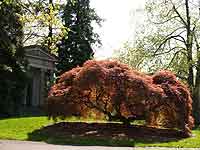 |
|---|
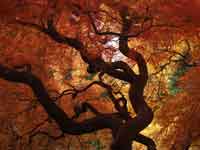 |
The variability and stateliness of the Japanese maple (Acer palmatum) makes it one of the more in-demand plants for the residential landscape. Japanese maples have long been a focal landscape plant at Lake View. Practically every form can be seen somewhere on the grounds, whether it is an Upright form maturing to approximately 20-feet in height or Dissectum (laceleaf types) that mostly display a weeping shrub-like habit and matures to a 5-foot height. Linearilobum or bamboo-leaf types, tend to be semi-dwarf specimens 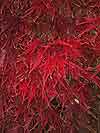 that can grow to 12-feet. Dwarf types may be laterally spreading, globular shaped or slow growing upright types that mature at 3 to 12-feet. Variegates have multiple colored leaves and are usually semi-dwarf in form.
that can grow to 12-feet. Dwarf types may be laterally spreading, globular shaped or slow growing upright types that mature at 3 to 12-feet. Variegates have multiple colored leaves and are usually semi-dwarf in form.
Weeping Canadian Hemlock
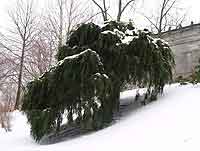 Two grand specimens of Tsuga canadensis ‘Sargentii’ include a smaller example in Section 9 near the Hanna Mausoleum along Edgehill Road. Located in Section 3 across from Daffodil Hill, this weeping Canadian hemlock was considered to be the largest specimen in the United States until the large branch on the right side failed under the snow weight during the 1996 snowstorm. Despite missing a lower limb, this specimen is still one of the largest weeping Canadian hemlocks to be seen.
Two grand specimens of Tsuga canadensis ‘Sargentii’ include a smaller example in Section 9 near the Hanna Mausoleum along Edgehill Road. Located in Section 3 across from Daffodil Hill, this weeping Canadian hemlock was considered to be the largest specimen in the United States until the large branch on the right side failed under the snow weight during the 1996 snowstorm. Despite missing a lower limb, this specimen is still one of the largest weeping Canadian hemlocks to be seen.
Display Labels
All new plantings in open areas and where feasible on private lots will have a plant display sign placed in a visible location identifying the botanic and common plant name. Every effort will be made to replace damaged signs and add new signs to established plants. Students are welcome to use leaf specimen for collections. Please contact the Horticulturist at the main office if anything more than leaf tissue is needed.
Plant Records
All new plantings are mapped and recorded with an accession number that is maintained in the plant records. At present time there is no accession labeling for field use. As previously mentioned, it is the goal of our Horticulture program to update and maintain Lake View’s plant inventory. We use a modified program of Treekeeper, Davey Tree’s municipally based plant record program to catalog our collection.
Cooperation with Botanic Institutions, Arboreta and Plant Nurseries
Lake View Cemetery maintains a policy of sharing germplasm with the horticultural industry and academia. Contact the Horticulturist at the main office for more information.
Use of Pesticides on the Grounds
All pesticides are applied by properly licensed personnel and contractors. Every effort to avoid the use of pesticides or optimize their effectiveness is done by incorporating integrated pest management in our plant health care program.
